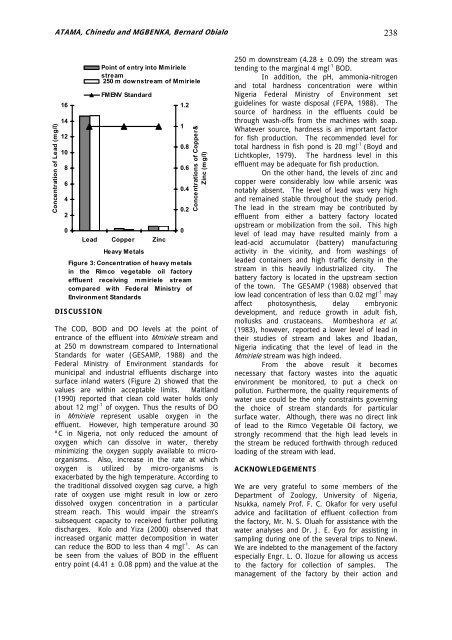ARI Volume 2 Number 1.pdf - Zoo-unn.org
ARI Volume 2 Number 1.pdf - Zoo-unn.org
ARI Volume 2 Number 1.pdf - Zoo-unn.org
- No tags were found...
Create successful ePaper yourself
Turn your PDF publications into a flip-book with our unique Google optimized e-Paper software.
ATAMA, Chinedu and MGBENKA, Bernard Obialo 238Concentration of Lead (mg/l)1614121086420Figure 3: Concentration of heavy metalsin the Rimco vegetable oil factoryeffluent receiving mmiriele streamcompared w ith Federal Ministry ofEnvironment StandardsDISCUSSIONPoint of entry into Mmirielestream250 m dow nstream of MmirieleFMENV StandardLead Copper ZincHeavy Metals1.20.80.60.40.2The COD, BOD and DO levels at the point ofentrance of the effluent into Mmiriele stream andat 250 m downstream compared to InternationalStandards for water (GESAMP, 1988) and theFederal Ministry of Environment standards formunicipal and industrial effluents discharge intosurface inland waters (Figure 2) showed that thevalues are within acceptable limits. Maitland(1990) reported that clean cold water holds onlyabout 12 mgl -1 of oxygen. Thus the results of DOin Mmiriele represent usable oxygen in theeffluent. However, high temperature around 30ºC in Nigeria, not only reduced the amount ofoxygen which can dissolve in water, therebyminimizing the oxygen supply available to micro<strong>org</strong>anisms.Also, increase in the rate at whichoxygen is utilized by micro-<strong>org</strong>anisms isexacerbated by the high temperature. According tothe traditional dissolved oxygen sag curve, a highrate of oxygen use might result in low or zerodissolved oxygen concentration in a particularstream reach. This would impair the stream’ssubsequent capacity to received further pollutingdischarges. Kolo and Yiza (2000) observed thatincreased <strong>org</strong>anic matter decomposition in watercan reduce the BOD to less than 4 mgl -1 . As canbe seen from the values of BOD in the effluententry point (4.41 ± 0.08 ppm) and the value at the10Concentrations of Copper&Zinc (mg/l)250 m downstream (4.28 ± 0.09) the stream wastending to the marginal 4 mgl -1 BOD.In addition, the pH, ammonia-nitrogenand total hardness concentration were withinNigeria Federal Ministry of Environment setguidelines for waste disposal (FEPA, 1988). Thesource of hardness in the effluents could bethrough wash-offs from the machines with soap.Whatever source, hardness is an important factorfor fish production. The recommended level fortotal hardness in fish pond is 20 mgl -1 (Boyd andLichtkopler, 1979). The hardness level in thiseffluent may be adequate for fish production.On the other hand, the levels of zinc andcopper were considerably low while arsenic wasnotably absent. The level of lead was very highand remained stable throughout the study period.The lead in the stream may be contributed byeffluent from either a battery factory locatedupstream or mobilization from the soil. This highlevel of lead may have resulted mainly from alead-acid accumulator (battery) manufacturingactivity in the vicinity, and from washings ofleaded containers and high traffic density in thestream in this heavily industrialized city. Thebattery factory is located in the upstream sectionof the town. The GESAMP (1988) observed thatlow lead concentration of less than 0.02 mgl -1 mayaffect photosynthesis, delay embryonicdevelopment, and reduce growth in adult fish,mollusks and crustaceans. Mombeshora et al.(1983), however, reported a lower level of lead intheir studies of stream and lakes and Ibadan,Nigeria indicating that the level of lead in theMmiriele stream was high indeed.From the above result it becomesnecessary that factory wastes into the aquaticenvironment be monitored, to put a check onpollution. Furthermore, the quality requirements ofwater use could be the only constraints governingthe choice of stream standards for particularsurface water. Although, there was no direct linkof lead to the Rimco Vegetable Oil factory, westrongly recommend that the high lead levels inthe stream be reduced forthwith through reducedloading of the stream with lead.ACKNOWLEDGEMENTSWe are very grateful to some members of theDepartment of <strong>Zoo</strong>logy, University of Nigeria,Nsukka, namely Prof. F. C. Okafor for very usefuladvice and facilitation of effluent collection fromthe factory, Mr. N. S. Oluah for assistance with thewater analyses and Dr. J. E. Eyo for assisting insampling during one of the several trips to Nnewi.We are indebted to the management of the factoryespecially Engr. L. O. Ilozue for allowing us accessto the factory for collection of samples. Themanagement of the factory by their action and
















